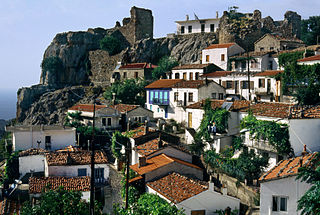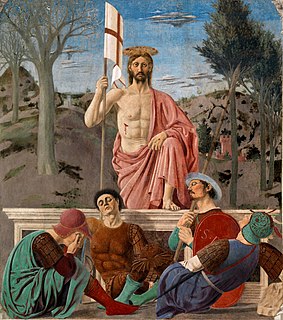Endymion primarily refers to:

Samothrace is a Greek island in the northern Aegean Sea. It is a municipality within the Evros regional unit of Thrace. The island is 17 km (11 mi) long and is 178 km2 (69 sq mi) in size and has a population of 2,859. Its main industries are fishing and tourism. Resources on the island include granite and basalt. Samothrace is one of the most rugged Greek islands, with Mt. Saos and its tip Fengari rising to 1,611 m (5,285 ft).
Guardian or The Guardian may refer to:

The Winged Victory of Samothrace, also called the Nike of Samothrace, is a marble Hellenistic sculpture of Nike, that was created in about the 2nd century BC. Since 1884, it has been prominently displayed at the Louvre and is one of the most celebrated sculptures in the world. H. W. Janson described it as "the greatest masterpiece of Hellenistic sculpture".

The Temple of Athena Nike is a temple on the Acropolis of Athens, dedicated to the goddesses Athena and Nike. Built around 420 BC, the temple is the earliest fully Ionic temple on the Acropolis. It has a prominent position on a steep bastion at the south west corner of the Acropolis to the right of the entrance, the Propylaea. In contrast to the Acropolis proper, a walled sanctuary entered through the Propylaea, the Victory Sanctuary was open, entered from the Propylaea's southwest wing and from a narrow stair on the north. The sheer walls of its bastion were protected on the north, west, and south by the Nike Parapet, named for its frieze of Nikai celebrating victory and sacrificing to their patroness, Athena and Nike.
Siren or sirens may refer to:
Andromeda most commonly refers to:

The Archaeological Museum of Samothrace is located in Samothrace of the Evros regional unit, in Greece. It has four rooms and an atrium, presenting the following:
- Reconstructed architectural remains of the sanctuary;
- Restored architectural features, sculptures and coins found in the sanctuary;
- Sculpture, miniature objects and pottery from the sanctuary and ancient city;
- Archaeological finds from cemeteries;
- A collection of inscriptions.
Acephaly is a term used to define:

In ancient Greek civilization, Nike was a goddess who personified victory. Her Roman equivalent was Victoria.
Phyllis Williams Lehmann, was an American classical archaeologist who specialised in the Samothrace temple complex, where she discovered a third statue of Winged Victory (1949), which is kept today at the Archaeological Museum of Samothrace and recovered missing fingers of the hand of the famous Winged Victory of Samothrace at the Louvre.

The term victory originally applied to warfare, and denotes success achieved in personal combat, after military operations in general or, by extension, in any competition. Success in a military campaign is considered a strategic victory, while the success in a military engagement is a tactical victory.
The Samuel Read Hall Library is the library at Lyndon State College, a member of the Vermont State College system. The library is named for Samuel Read Hall, an educational pioneer and native Vermonter and is located in the Library Academic Center on the college's campus in Lyndon Center. The mission statement of the SRH Library is “to provide a haven for inquiry and reflection. We support students and the broader community by providing resources, staff and services that encourage research, engage curiosity, and cultivate lifelong learning.”
Dwarf or dwarves may refer to:
Amazon most often refers to:
A goddess is a female deity.

The Nike of Paionios is an ancient statue of the Greek goddess of victory, Nike, made by sculptor Paionios 425-420 BC. Made of Parian marble, the statue was restored from many fragments, but is lacking face, neck, forearms, part of left leg, toes and some fragments of drapery. It also had wings. The goddess is shown landing gently on her left foot, with the drapery blown against her body.

Winged Victory is a World War I memorial in the U.S. state of Washington, which consists of four figures of uniformed persons atop a granite pedestal eclipsed by a fifth figure depicting the Winged Victory of Samothrace.
This page is based on this
Wikipedia article Text is available under the
CC BY-SA 4.0 license; additional terms may apply.
Images, videos and audio are available under their respective licenses.







